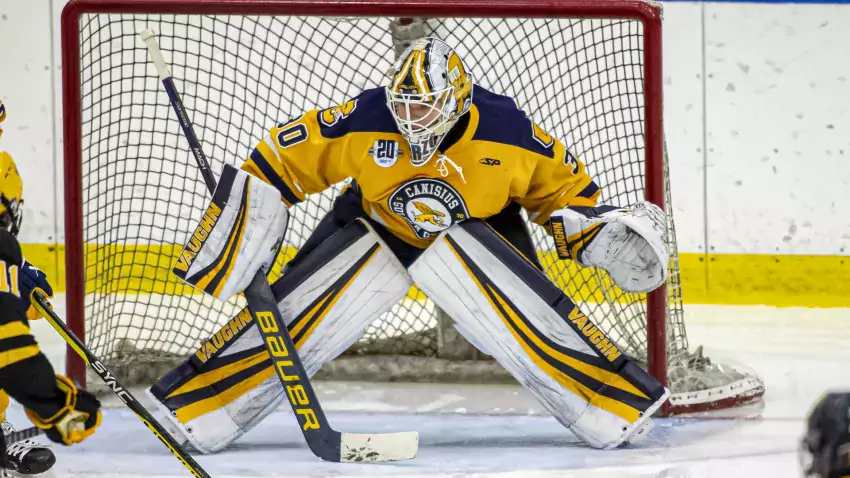
Hello: Jacob Barczewski

After the departure of Erik Portillo to professional endeavors following the Frozen Four last spring, it was paramount for the Wolverines coaching staff to find replacements in net for this upcoming hockey season. Enter Jacob Barczewski, who comes to Michigan as a grad transfer after playing four years at Canisius University in Buffalo. Barczewski is expected to be Michigan’s starting goalie this season, so let’s get to know him in another Hockey Hello.
Quick Background
Jacob Barczewski hails from O’Fallon, Missouri, in the outer reaches of the St. Louis area. He played two seasons in the USHL with the Tri-City Storm, posting a .904 SV% in 59 appearances before enrolling at Canisius University in the fall of 2019 for the upcoming 2019-20 NCAA season. Barczewski was Canisius’ primary goalie for all four seasons he was with the program, logging 28, 11 (in a 17 game COVID-shortened season), 29, and 32 games. In total that adds up to 100 gams, with Barczewski being credited with 44 wins, 6 career shutouts, and a .917 SV%.
Barczewski’s first season saw him post a .905 and a 2.92 GAA, but his numbers were much stronger over his sophomore to senior seasons. Those years won him praise in Atlantic Hockey circles, earning honors within the conference for his .926 SV% in the shortened 2020-21 season, in addition to being named Canisius Male Athlete of the Year. His .923 the next season earned him All-AHA First Team, and again he was named team MVP by his coaches and teammates. As a senior, his numbers dipped down slightly (though it was solely due to one NCAA Tournament game), but he was still named All-AHA Third Team and his greatest triumph was on the ice.
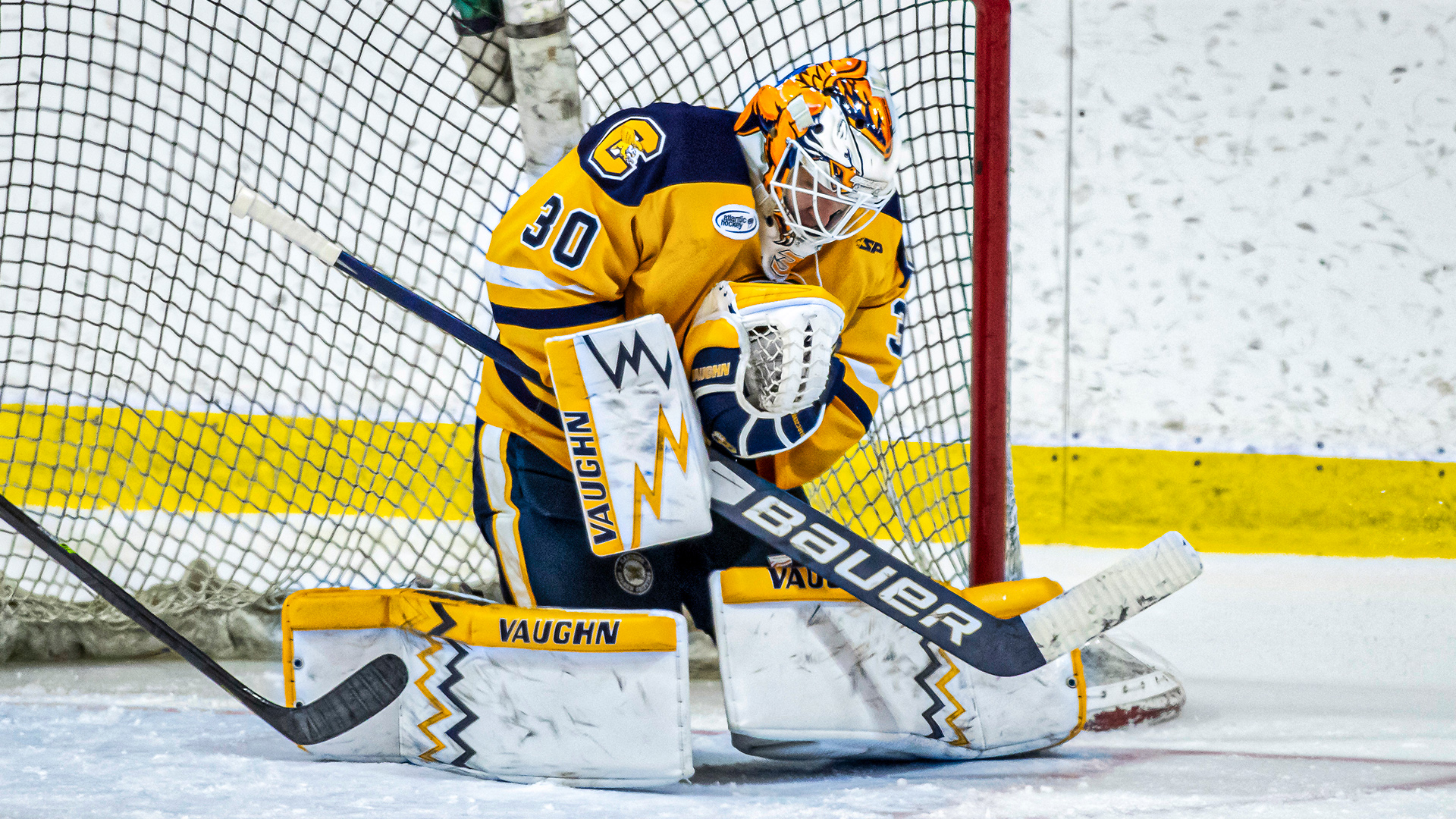
[Canisius Athletics]
Indeed, Barczewski’s career at Canisius hit a climax in the Atlantic Hockey Association Championship Game, when he and his Golden Griffins teammates blanked Holy Cross 3-0 to make the NCAAs for the first time since 2013. The euphoria from that victory was short-lived as Canisius played the University of Minnesota, 1st overall seed, in their first game of the NCAA Tournament five days later. Despite holding a 2-1 lead early in the 2nd period, the Gophers power-play took over the game and Minnesota ended up winning 9-2, a typical score for the lopsided nature of the 1 vs 16 matchup. That defeat ended the season for the Griffins and the career of Barczewski at Canisius.
The 2022-23 season was good statistically for Barczewski, who started all 32 games he appeared in. He finished with a .918 SV%, down from .925 before he had to face Minnesota with a Canisius defense in front of him. More importantly, Barczewski became noticeably stronger as the season progressed, which was exemplified by him registering 3 shutouts he in his last 10 starts. After the season, Barczewski entered the portal and then committed to Michigan with the intention of being the starter. Michigan goalie Noah West, who had originally entered the transfer portal after the season, re-committed to Michigan for his senior year as well, giving us the tandem for this upcoming season.
[AFTER THE JUMP: How we can try to evaluate goalies]
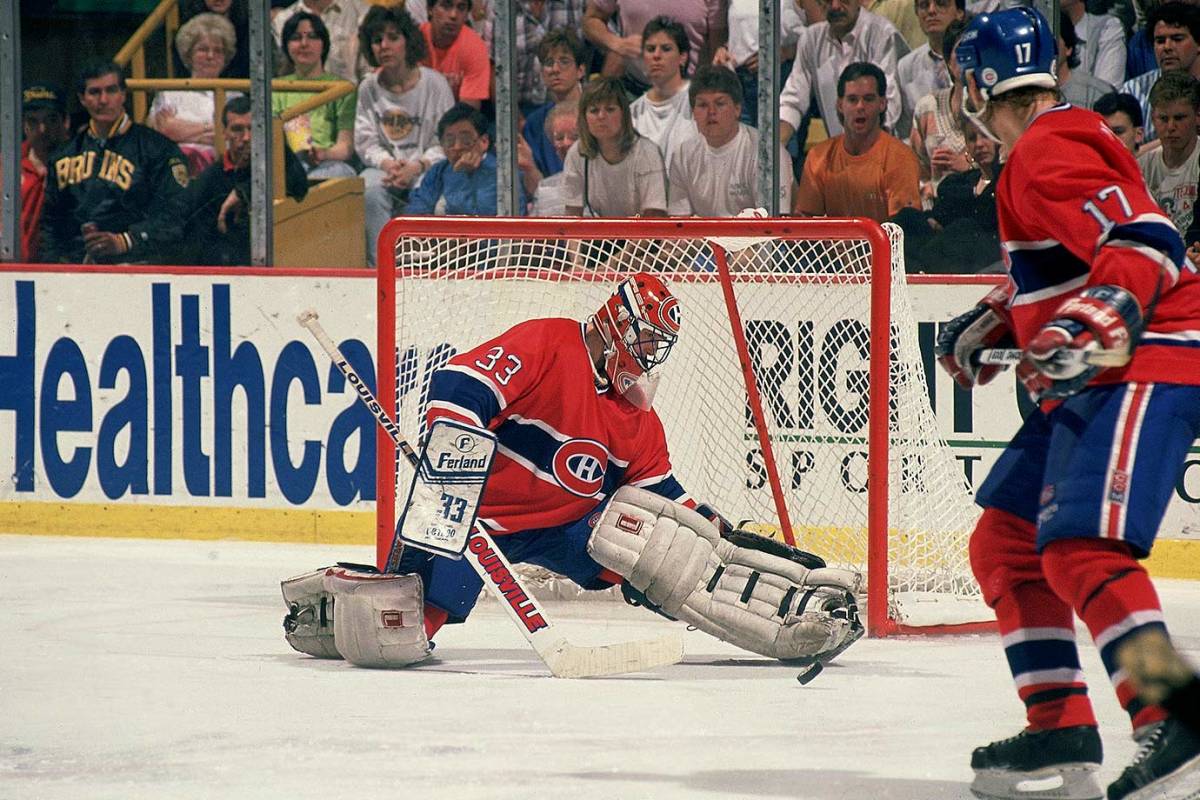
The Butterfly's most influential user [Sports Illustrated]
Evaluating Goalies in General
When it comes to goaltending, most head coaches at highly competitive levels will generally admit they know next to nothing about the position and how to evaluate it. This is why goalie coaches have become such an integral part of a successful team's coaching staff, and why Michigan missed having one on staff so badly last season. Most head coaches look at size and basic stats like Goals Against Average (GAA) and Save Percentage (SV%) as the benchmark in assessing a goalie, but there is much more than that, something that goalie coaches have a much better grasp of.
In today's game, there are two common similarities between most goalies. One, they are generally 6'3" or taller, and two, they use the Butterfly style to stop shots. It's hard to argue with the logic to think that using a bigger goalie to protect the 24 square feet of the net is a good idea, but there are exceptions to that thinking - Juuse Saros of the Nashville Predators is regarded as one of the top goalies in the NHL and he stands at 5'11". Size is extremely useful, but freakish athleticism, which Saros possesses, is just as compelling an asset as size.
The Butterfly style of goaltending, first used by Glenn Hall in the 1960s and later made popular by Patrick Roy in the late 1980s/1990s, focuses on stopping shots by having a goalie drop to his knees and spreading his legs towards each post, which, in theory, greatly decreases the chance of a team scoring a goal along or just off the ice. Originally, it was a solution for the prevailing style of offence of the era, when low shots along the ice were quite common among forwards as a tactic to beat stand-up goalies. Butterfly goalies started appearing in bunches in the mid-to-late 90s, after Roy’s emergence as a dominant goaltender, and throughout the 2000s into the early 2010s, those Butterfly goalies suddenly began to be larger and larger, as the tall goalie model took the NHL by storm.
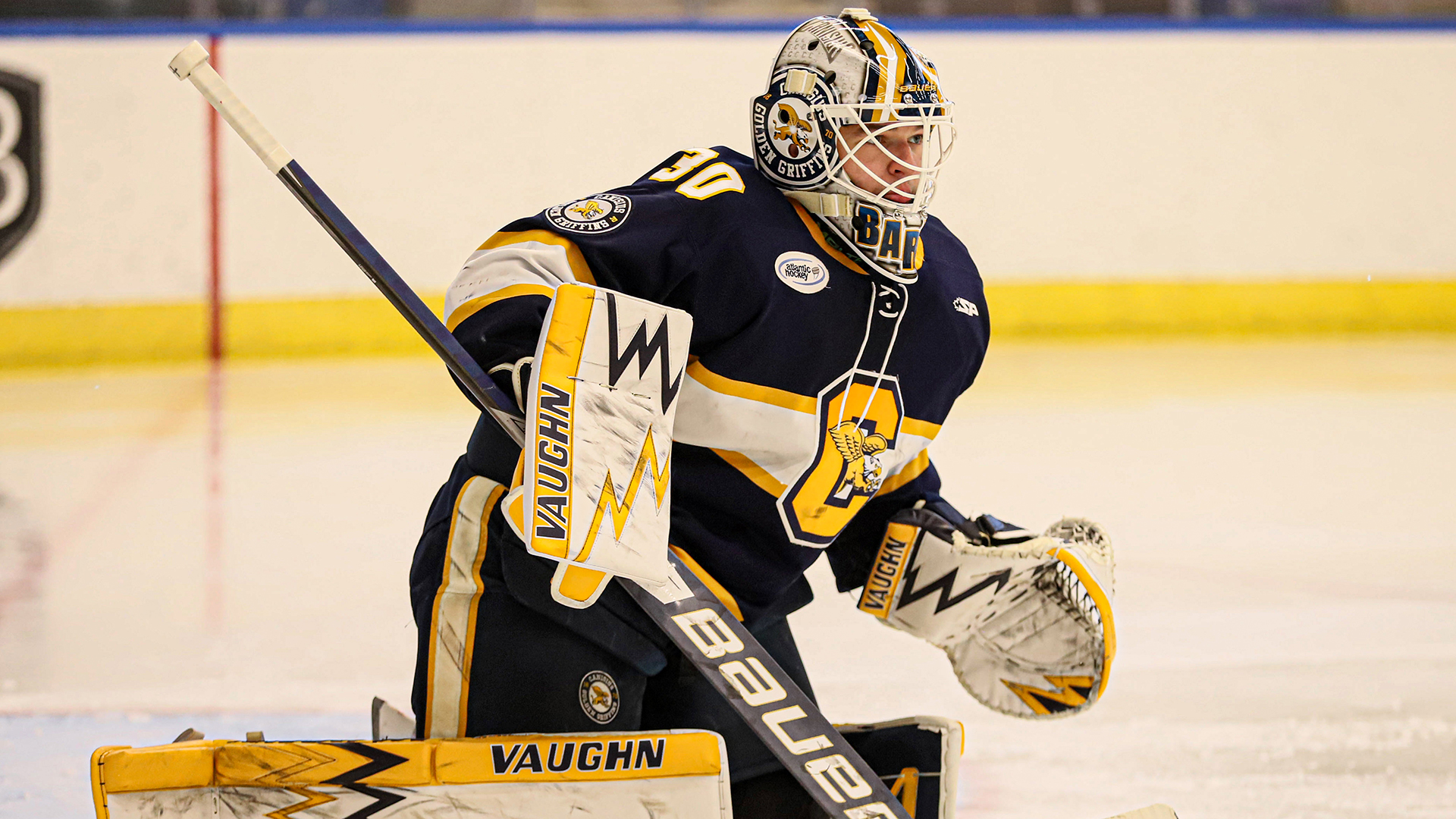
The Butterfly in action with our main character [Canisius Athletics]
For a few seasons, having a big goalie using the Butterfly was hugely successful and goal prevention metrics ticked up considerably. But eventually, coaches being coaches, realized that having tall and bulky goalies in net may be sacrificing athleticism, and that perhaps those goalies, and the Butterfly in general, were vulnerable to shots coming in motion. In other words, if their players moved the puck laterally in the offensive zone, forcing the goalie to slide side to side, they could open up holes which created high quality scoring chances. Michigan’s offence in the last few years has been proficient at this, creating goals through effective cross-seam passing. Goalies (and goalie coaches) have been adapting to this change in offence and have worked on efficiently moving laterally with minimal upper body movement to cut back on the flailing and desperation that most goalies had to resort to, which resulted in areas being exposed to shooters.
With all of that in mind, when we look at Jacob Barczewski, it really isn't fair to evaluate him based solely on wins, GAA or SV%, because goaltending is much more nuanced than that. Not to mention the fact that Barczewski was going up against very different competition in the AHA than he will see in the B1G. What we can look at, though, thanks to stats generated from Instat, is how Barczewski fared against different kinds of shot while in the Butterfly position and while in motion (sliding across), compared to what Erik Portillo did last year.
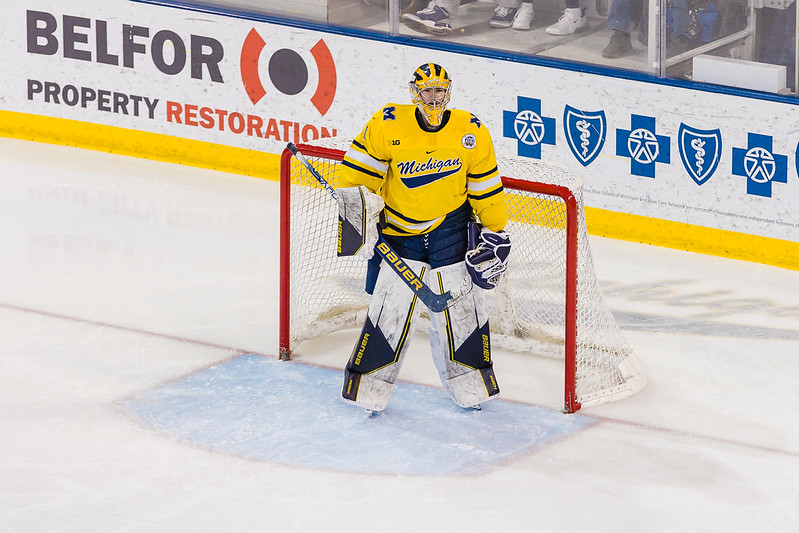
[Grace Beal]
Barczewski vs. Portillo
Both Barczewski and Portillo are left-hand-catching goalies which means when looking at the charts below, the right side of the chart is the 'glove side' and the left side of the chart is the 'stick or blocker side'.


BUTTERFLY STANCE SAVE PERCENTAGE
First, we are going to look at shots faced when in the Butterfly position. It is worth noting that we are not indicating where on the ice the shots are taken from, or if they are deflected or screened. These are just raw numbers from the Butterfly position. Overall, Barczewski had a slightly higher Save Percentage from the Butterfly position at .939 compared to Portillo's .930. When we break it down into the 9 different zones of the net, which are High Glove, Mid Glove and Lower Glove, Middle High, Middle-Middle and Low Middle (5-Hole) and Upper Blocker, Mid Blocker, and Low Blocker, there are some interesting comparisons
Starting with High Glove, Barczewski had a .778% SV% compared to Portillo who had an .845. You would think that difference could be attributed to Portillo being 6'6 and Barczewski being 6'1", which allows Portillo to better cover the top of the net, but when you look at High Blocker, Barczewski had an .891 SV% compared to Portillo's .810. Perhaps no correlation with height at all.
When comparing Mid Glove, Barczewski's Save Percentage was .940, compared to Portillo's .876. In the Mid Blocker zone, both goalies put up almost identical Save Percentages with Portillo coming in at .906 and Barczewski at .903. Both goalies put up good numbers at Low Glove with Barczewski coming in at .965 and Portillo at .948. At the Low Blocker zone, Portillo had a Save Percentage of .971 compared to .956 for Barczewski. In the Low Middle Zone (5-Hole), Portillo's Save Percentage was .944 compared to Barczewski's .935. In summation, there are no obvious trends between the two, each with specific zone weaknesses relative to the other but there are no broad correlations, such as one clearly being better high vs. low or glove vs. blocker. Moreover, it's worth re-emphasizing that these numbers do not reflect on where shots were taken from, and if there were screens or deflections. While we don’t have that data, access to it could provide a more informative picture of Barczewski vs. Portillo.
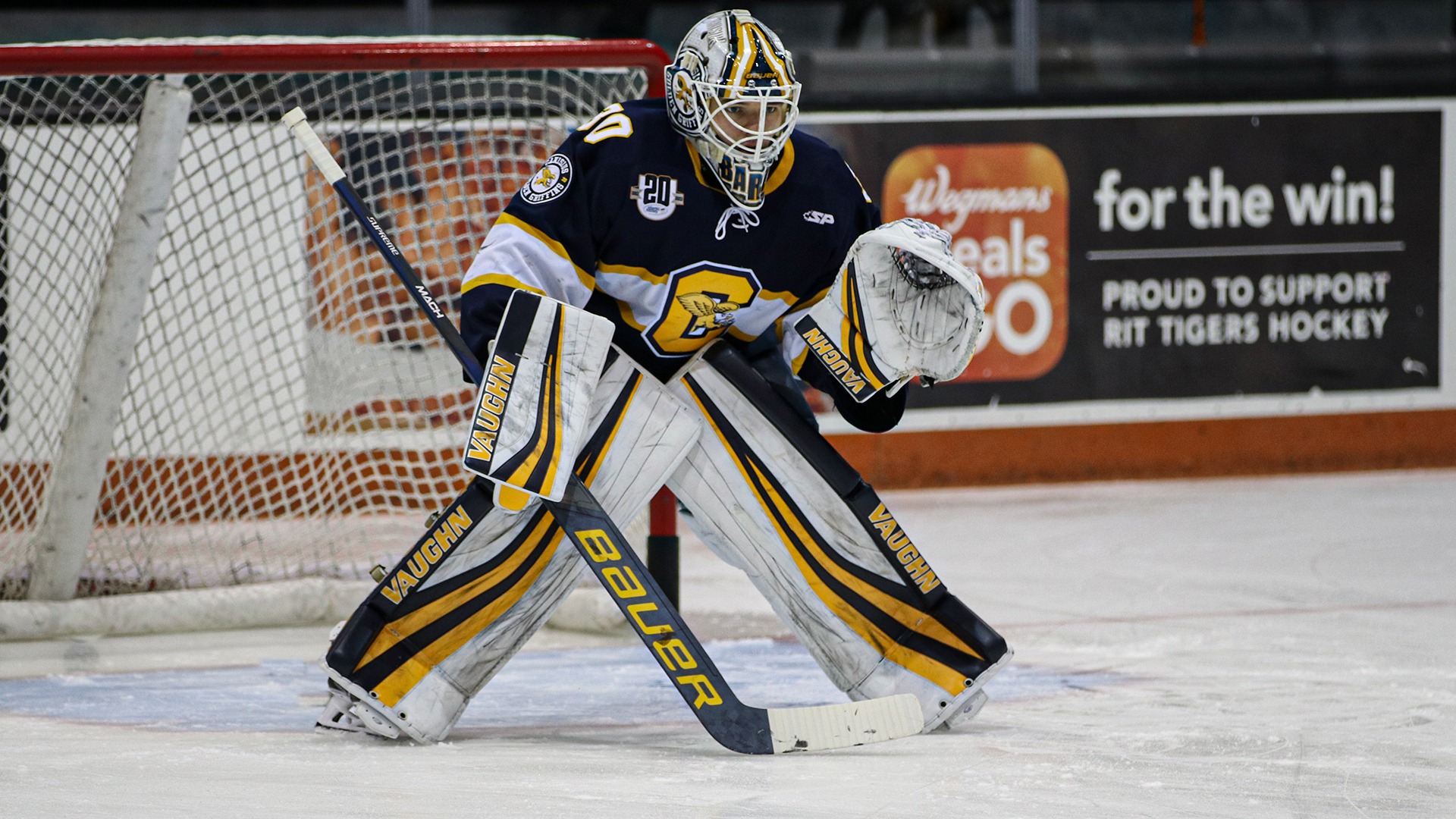
[Canisius Athletics]
IN MOTION SAVE PERCENTAGE


The next comparison we will do is when a goalie is in motion when the shot was taken, which usually was initiated by a lateral pass that caused the goalie to change position. We are going to break it down into the same nine zones of the net as above and again, this does not reflect where the shot is coming from or if there is a screen or deflection. Starting with High Glove yet again, Portillo sported the better Save Percentage at .336 compared to Barczewski's .250, but both goalies only faced minimal shots in those locations. In the High Blocker zone, again Portillo had the better Save Percentage with .636 compared to Barczewski's .333. At the Mid Glove zone, Barczewski sported a .500 SV% compared to Portillo's 474., so no major difference there.
At Mid Blocker, Portillo again had the better number with a sterling SV% of .933 compared to Barczewski's .800. In the Low Glove zone, Barczewski had a .944 SV% with Portillo having a much lower .655 SV%. In the Low Blocker zone, Barczewski stopped 92.3% of the shots that came at him while Portillo had a Save Percentage of .893. Portillo was perfect in the Low Middle or 5-Hole zone, saving 18 of 18 shots while Barczewski had a .684 SV%. In general, these numbers support the conclusion that Portillo was better while in motion than Barczewski close to across the board, but especially in the middle and high zones. Whether this is a direct reflection of their goaltending acumen or more related to the defenses played in front of them/quality of shots taken, is another question that we don’t have an answer to.

[Harry Scull Jr./Buffalo News]
Final Word
When looking into my 'Crystal Puck', I see Barczewski getting the bulk of the work, between 70%-75% of the starts for the Wolverines and Noah West getting the opportunity to show what he can do with the rest. Comparing Barczewski's numbers to Portillo's and attempting to predict how Barczewski will fare in that workload is difficult. The numbers we’ve presented in this piece provids a glimpse of the body of work that Barczewski displayed last year but by no means offers an assessment of how he will perform this upcoming season. Numerous factors such as physical condition, speed of play in the Big 10 compared to the Atlantic Hockey Association, handling loose pucks, communication with teammates, coaching and adjustment to Michigan's overall style of play are also major factors that will determine how the season will go.
I also see new Assistant Coach Kevin Reiter playing a major part in the continued development of Barczewski. As the numbers reflected above, one area of Barczewski's game that needs improvement is high glove saves from both the Butterfly Stance and while in motion. With him being 6'1", one way to help improve on that is adjusting the catching glove placement. Instead of holding his catching hand at the side, he would hold the glove up and extend it slightly away from his body which takes away the trajectory of a shot that is going from the ice to the top corner of the net. This is just one suggestion but is an example of the manner in which Reiter can improve Barczewski’s game and help him transition to Michigan. The data we’ve presented in this piece gives us insights into Barczewski’s game and his possible weaknesses, but projection remains difficult until we know how the team and Barczewski coexist and the improvements that the staff can make with the player. Regardless of what happens, the further development of Michigan’s projected starting goalie will be a hugely important storyline to follow.
September 12th, 2023 at 10:59 AM ^
Appreciate the breakdown of the two goalies - and indeed, much more to it than meets the eye. My hope, if nothing else, is that we get consistent and solid goaltender play this year versus what we saw last year from Portillo.
September 12th, 2023 at 12:32 PM ^
But what is his save% when randomly wandering away from the net to play pucks he has no gawd-awful reason to?
September 12th, 2023 at 2:23 PM ^
Would that be the Turco stat category?
September 12th, 2023 at 2:31 PM ^
The Portillo Walkabout Factor.
September 12th, 2023 at 12:59 PM ^
Do we know why Noah West changed his mind? Did it have anything to do with hiring Reiter?
September 12th, 2023 at 6:05 PM ^
Honestly, he probably wasn’t receiving much interest in the portal after hardly playing the last couple years at Michigan. Michigan was able to offer him an increased workload as well
September 12th, 2023 at 7:52 PM ^
excellent write up. i sure do miss playing goalie.
quality of defensemen and defense schematic also plays a huge role in SV% and GAA.
example, easy to have a really high SV% if your defensive scheme crowds the slot and forces a TON of outside shots
September 13th, 2023 at 4:35 PM ^
Outstanding article again--love the historical call backs and comparison with Portillo
September 15th, 2023 at 9:20 PM ^
Just circled back to read this more carefully. Great analysis, and I come away feeling slightly more encouraged that we won't have as much of a goaltending drop-off as I'd feared (though, to be fair, some of that is just remembering how much Portillo tailed off).
One quibble, those images showing percentages of each zone are tiny. I was hoping to expand them to see the smaller sets of numbers as those look like they might be the sample sizes (which is what I was hoping to see).
Comments